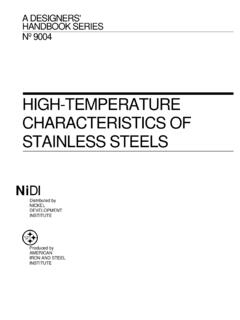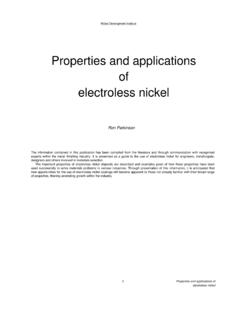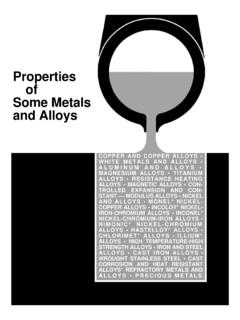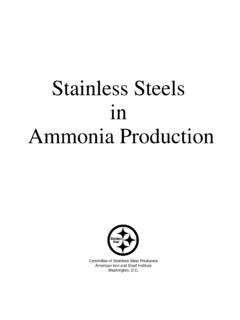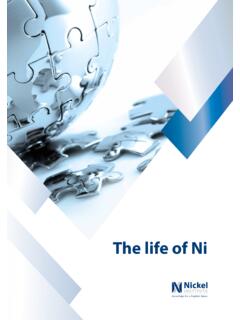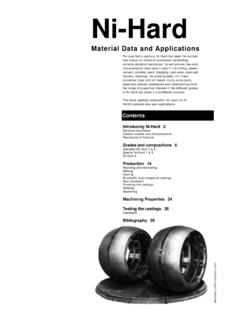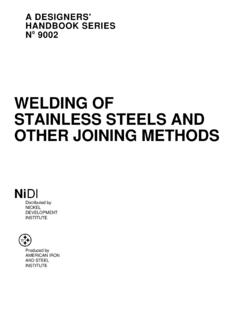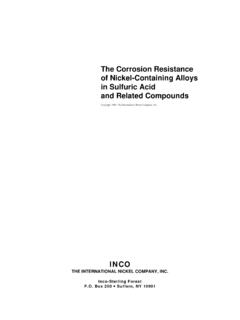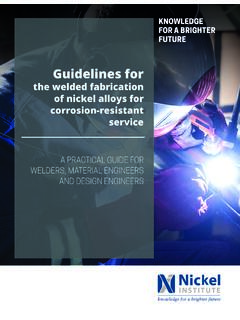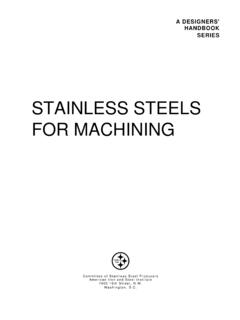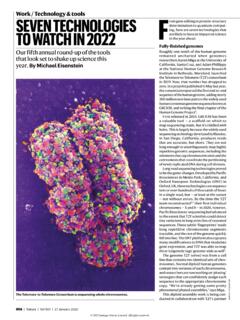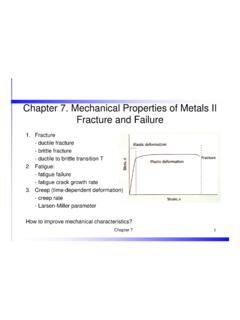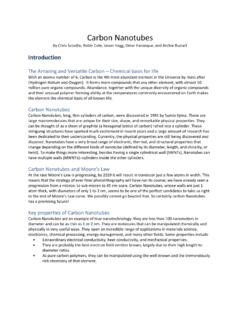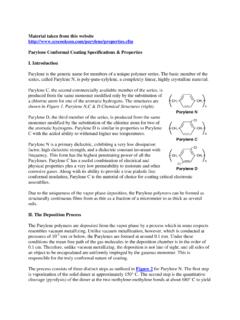Transcription of Design Guidelines for the Selection and Use of Stainless ...
1 A DESIGNERS' HANDBOOK SERIES No 9014 Design Guidelines FOR THE Selection AND USE OF Stainless STEELNiDl Distributed by NICKEL DEVELOPMENT INSTITUTE courtesy of AMERICAN IRON AND STEEL INSTITUTE AND SPECIALTY STEEL INSTITUTE OF NORTH AMERICA CONTENTS Introduction .. 1 Identification of Stainless Steel .. 1 Guidelines for Selection .. 5 Corrosion Resistance .. 5 Material Selection .. 5 Mechanical & Physical Properties .. 9 Austenitic .. 9 Ferritic .. 9 Martensitic .. 11 Precipitation Hardening .. 12 High-Temperature Mechanical Properties .. 14 Thermal Stability .. 14 Low-Temperature Mechanical Properties .. 16 Heat Transfer Properties .. 17 Sizes, Shapes, and Finishes .. 18 Fabrication .. 18 Hot Forming .. 18 Cold Forming.
2 25 Machining .. 27 Joining .. 28 Welding .. 28 Soldering .. 29 Brazing .. 29 Fastening .. 29 Surface Protection & Cleaning .. 30 Appendix A Corrosion Characteristics .. 31 Appendix B Figures .. 35 References .. 52 The material presented in this publication has been prepared for the general information of the reader and should not be used or relied on for specific applications without first securing competent advice. The Nickel Development Institute, its members, staff and consultants do not represent or warrant its suitability for any general or specific use and assume no liability or responsibility of any kind in connection with the information herein. 1 INTRODUCTION Stainless steels are iron-base alloys containing or more chro-mium. They have been used for many industrial, architectural, chemical, and consumer applications for over a half century.
3 Currently there are being marketed a number of Stainless steels originally recognized by the American Iron and Steel Institute (AISI) as standard alloys. Also commer-cially available are proprietary Stainless steels with special characteristics. (See Appendix A.) With so many Stainless steels from which to choose, designers should have a ready source of information on the characteristics and capabilities of these useful alloys. To fill this need, the Committee of Stainless Steel Producers initially prepared this booklet. The data was reviewed and updated by the Specialty Steel Industry of North America (SSINA). Written especially for Design engineers, it presents an overview of a broad range of Stainless steels both standard and proprietary their compositions, their properties, their fabrication, and their use. More detailed information on the 60 standard grades, with special emphasis on the manufacture, finish designations and dimensional and weight tolerances of the product forms in which they are marketed, is contained in the Iron and Steel Society of the AIME (the American Institute of Mining, Metallurgical and Petroleum Engineers) "Steel Products Manual Stainless and Heat Resisting Steels.
4 " The AIME undertook the publication, updating and sale of this manual after the AISI discontinued publication in 1986. IDENTIFICATION Reference is often made to Stainless steel in the singular sense as if it were one material. Actually there are over 50 Stainless steel alloys. Three general classifications are used to identify Stainless steels. They are: 1. Metallurgical Structure. 2. The AISI numbering system: namely 200, 300, and 400 Series numbers. 3. The Unified Numbering System, which was developed by American Society for Testing and Materials (ASTM) and Society of Automotive Engineers (SAE) to apply to all commercial metals and alloys. There are also a number of grades known by common names that resemble AISI designations but that are not formally recognized by AISI. These common names, which are neither trademarks nor closely associated with a single producer, are shown and identified in the tables.
5 These common (non-AISI) names do not appear in the ASTM specifica-tions, so it is important to use the UNS designations with these grades. On the following pages there is a description of these classifications. Tables 1-5 list Stainless steels according to metallurgical structure: austenitic, ferritic, martensitic, precipitation hardening, and duplex. NiDIDistributed by NICKEL DEVELOPMENT INSTITUTE 2 Austenitic Stainless steels (Table 1) containing chromium and nickel are iden-tified as 300 Series types. Alloys contain-ing chromium, nickel and manganese are identified as 200 Series types. The stain-less steels in the austenitic group have different compositions and properties, but many common characteristics. They can be hardened by cold working, but not by heat treatment. In the annealed condition, all are essentially nonmagnetic, although some may become slightly magnetic by cold working.
6 They have excellent corrosion resistance, unusually good formability, and increase in strength as a result of cold work. Type 304 (frequently referred to as 18-8 Stainless ) is the most widely used alloy of the austenitic group. It has a nominal composition of 18% chromium and 8% nickel. Table 1 AUSTENITIC Stainless STEELS TYPE Equivalent UNS TYPE Equivalent UNS 201 S20100 310 S31000 202 S20200 310S S31008 205 S20500 314 S31400 301 S30100 316 S31600 302 S30200 316L S31603 302B S30215 316F S31620 303 S30300 316N S31651 303Se S30323 317 S31700 304 S30400 317L S31703 304L S30403 317 LMN S31726 302HQ S30430 321 S32100 304N S30451 330 N08330 305 S30500 347 S34700 308 S30800 348 S34800
7 309 S30900 384 S38400 309S S30908 Ferritic Stainless steels (Table 2) are straight-chromium 400 Series types that cannot be hardened by heat treatment, and only moderately hardened by cold working. They are magnetic, have good ductility and resistance to corrosion and oxidation. Type 430 is the general-purpose Stainless of the ferritic group. Table 2 FERRITIC Stainless STEELS TYPE EquivalentUNS TYPE EquivalentUNS 405 S40500 430 FSeS43023 409 S40900 434 S43400 429 S42900 436 S43600 430 S43000 442 S44200 430F S43020 446 S44600 Martensitic Stainless steels (Table 3) are straight-chromium 400 Series types that are hardenable by heat treatment.
8 They are magnetic. They resist corrosion in mild environments. They have fairly good ductility, and some can be heat treated to tensile strengths exceeding 200,000 psi (1379 MPa). Type 410 is the general-purpose alloy of the martensitic group. Table 3 MARTENSITIC Stainless STEELS TYPE EquivalentUNS TYPE EquivalentUNS 403 S40300 420F S42020 410 S41000 422 S42200 414 S41400 431 S43100 416 S41600 440A S44002 416 SeS41623 440B S44003 420 S42000 440CS44004 Precipitation-hardening Stainless steels (Table 4) are chromium-nickel types, some containing other alloying ele-ments, such as copper or aluminum. They can be hardened by solution treating and aging to high strength.
9 Table 4 PRECIPITATION HARDENING Stainless STEELS UNS UNS S13800 S17400 S15500 S17700 Duplex Stainless steels (Table 5) have an annealed structure which is typically about equal parts of austenite and ferrite. Although not formally defined, it is gener-ally accepted that the lesser phase will be at least 30% by volume. Duplex Stainless steels offer several advantages over the common austenitic Stainless steels. The duplex grades are highly resistant to chloride stress corro-sion cracking, have excellent pitting and crevice corrosion resistance and exhibit about twice the yield stength as conven-tional grades. Type 329 and 2205 are typical alloys. With respect to the Unified Numbering System, the UNS designations are shown alongside each AISI type number, in Tables 1-5, except for four Stainless steels (see Tables 4 and 5) for which UNS designations only are listed.
10 Table 5 DUPLEX Type UNS 329 S32900 2205 S31803,S32205 3 4 5 Guidelines FOR Selection Stainless steels are engineering materials with good corrosion resistance, strength, and fabrication characteristics. They can readily meet a wide range of Design criteria load, service life, low maintenance, etc. Selecting the proper Stainless steel essentially means weighing four elements. In order of importance, they are: 1. Corrosion or Heat Resistance the primary reason for specifying Stainless . The specifier needs to know the nature of the environment and the degree of corrosion or heat resistance required. 2. Mechanical Properties with par-ticular emphasis on strength at room, elevated, or low temperature.
